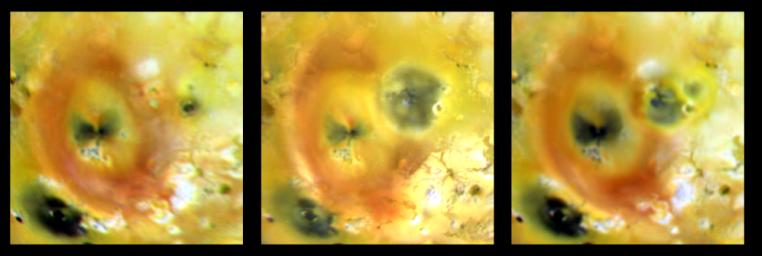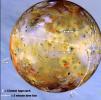
|
Changes at Pillan Patera
- Click the image above for a larger view
- Full-Res JPEG (1040 x 349) (39.9 kB)
- Full-Res TIFF (1040 x 349) (1.1 MB)
Caption:
Dramatic changes have occurred at the volcanically active Pillan Patera region of Jupiter's moon Io over the past three years, as seen in this set of three images taken by NASA's Galileo spacecraft.
The image on the left was taken in April 1997. The middle image shows the same area in September 1997 after a huge eruption occurred. The eruption produced the large, dark deposit just above and to the right of the center. The deposit, which is 400 kilometers (250 miles) in diameter, surrounds Pillan Patera and covers part of the bright red ring, which is the deposit from Pele's plume.
The image on the right was acquired in July 1999 and is our best view of the region since 1997. It shows changes that have taken place on the surface since the eruption almost two years ago. The red material from Pele, which probably contains some form of sulfur, has started to cover, but has not yet entirely obscured, the dark material around Pillan. This may indicate that the plumes of both Pillan and Pele are still active. This image also shows that a small, unnamed volcano to the right of Pillan has erupted, depositing dark material surrounded by a yellow ring, which is most visible where it covers some of the dark material from Pillan's 1997 eruption.
Some of the color differences between the three images are the effects of different lighting conditions when the images were taken. The apparent change in brightness of the dark feature in the lower left corner (Babbar Patera) and of parts of Pele's red plume deposit, are thought to be due to changes in illumination. However, such illumination changes cannot explain the dramatic changes seen at Pillan.
Filters in red, green, and violet wavelengths were combined to produce these images. The color range is slightly enhanced from what the human eye might see at Io. North is to the top of the picture, and the Sun illuminates the surface from the right on the first image, and from the left for the other two. The images are centered at 19 degrees south latitude and 250 degrees west longitude and cover an area approximately 1,650 kilometers wide and 1,750 kilometers high (1,025 miles and 1,090 miles). The resolution of the images on the left and right is about 12 kilometers (7 miles) per picture element. The middle image has a slightly better resolution of about 5 kilometers (3 miles) per picture element. The images taken on April 4, 1997 were from a range of 600,486 kilometers (375,304 miles) by Galileo's camera. The images taken on September 19, 1997, were from a range of 505,628 kilometers (316,017 miles). The July 2, 1999 images were taken from a distance of 585,452 kilometers (365,908 miles).
|
Background Info:
The Jet Propulsion Laboratory, Pasadena, CA manages the Galileo mission for NASA's Office of Space Science, Washington, DC. JPL is a division of the California Institute of Technology, Pasadena, CA.
This image and other images and data received from Galileo are posted on the World Wide Web, on the Galileo mission home page at http://solarsystem.nasa.gov/galileo/ . Background information and educational context for the images can be found at http://www.jpl.nasa.gov/galileo/sepo .
Cataloging Keywords:
| Name | Value | Additional Values |
|---|---|---|
| Target | Io | |
| System | Jupiter | |
| Target Type | Satellite | |
| Mission | Galileo | |
| Instrument Host | Galileo Orbiter | |
| Host Type | Orbiter | |
| Instrument | Solid-State Imaging (SSI) | |
| Detector | ||
| Extra Keywords | Color, Plume, Volcano | |
| Acquisition Date | ||
| Release Date | 1999-10-08 | |
| Date in Caption | 1997-04-04 | 1997-09-19, 1999-07-02 |
| Image Credit | NASA/JPL/University of Arizona | |
| Source | photojournal.jpl.nasa.gov/catalog/PIA02501 | |
| Identifier | PIA02501 | |

